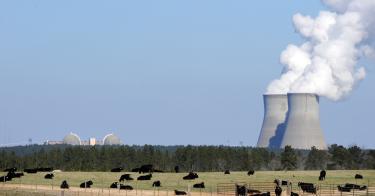The drama continues with two of the four nuclear power reactors being built in the U.S. today. On Thursday, the Georgia Public Service Commission voted on measures to continue financing and building the Vogtle 3 and 4 reactors. The project has faced years of schedule delays and billions in cost overruns. The news comes even as two reactors in South Carolina have been indefinitely stalled.
Many feared that had Georgia halted construction it would have sent a chilling signal about the future of nuclear power in the U.S. In fact, Vogtle’s struggles have only served to underscore some of the deep seated problems in America’s approach to nuclear power.
Southern Company applied to the Nuclear Regulatory Commission for a license to construct and operate in March 2008, following Congress’s passage of a production tax credit for new nuclear plants in 2005. The project was expected to be finished in 2018, but is now targeted for no later than June 2022 according to the Georgia Public Service Commission’s recent decision. This is despite being awarded $6.5 billion in federal loan guarantees and the promise of federal tax credits once the reactors were up and running.
The last reactor to have come online was the Tennessee Valley Authority’s Watts Bar 2 in 2015, after a 20 year hiatus in any new nuclear power construction. People were hailing it as a banner day for nuclear power with a glimmer of hope for the nuclear renaissance that had been expected after the 2005 Energy Policy Act.
Back then The Heritage Foundation wrote of the predictable story to follow:
A few more [reactors] may trickle in as billions in taxpayer-backed loan guarantees still remain through Department of Energy loan programs—the key word being “trickle.”
But more government handouts do not equate to a thriving industry, whether in commercial nuclear power or any other industry. Instead of bringing about a nuclear renaissance, subsidies have tied nuclear energy investment and innovation to political whims rather than smart business decisions, common sense, and good ideas.
An industry dependent on government favors can limp along provided the promise of more subsidies remains; but an “industry that grows out of the free market will be stronger over the long term.”
Far too many politicians and bureaucrats have supported federal tax credits and other subsidies for nuclear power, as if nuclear were an approved energy technology of the right just as wind and solar power are the golden children of the left that ought to be subsidized. But nuclear power can thrive only if Congress stops compensating for bad federal policy with a patchwork of subsidies.
If there is to be hope for a thriving commercial nuclear industry in the U.S., Congress needs to address the underlying policies that have mired down the U.S. nuclear industry over the last several decades. Chief areas among them are the burdensome federal licensing process, an overly prescriptive and costly approach to regulation, and nuclear waste management, the abysmal mismanagement of which has created uncertainty for the existing and future nuclear industry. Heritage has an abbreviated list of things the Trump administration and Congress can do that don’t involve more government handouts.
The benefits of nuclear power are myriad and the American nuclear industry has the potential to do more in the 21st century. Congress and the administration need to get to the hard work of addressing the government-induced barriers to a thriving nuclear industry so that Georgia’s story doesn’t become the norm.
This piece originally appeared in The Daily Signal



